MERCEDES-BENZ ML350 1997 Complete Repair Manual
Manufacturer: MERCEDES-BENZ, Model Year: 1997, Model line: ML350, Model: MERCEDES-BENZ ML350 1997Pages: 4133, PDF Size: 88.89 MB
Page 2861 of 4133
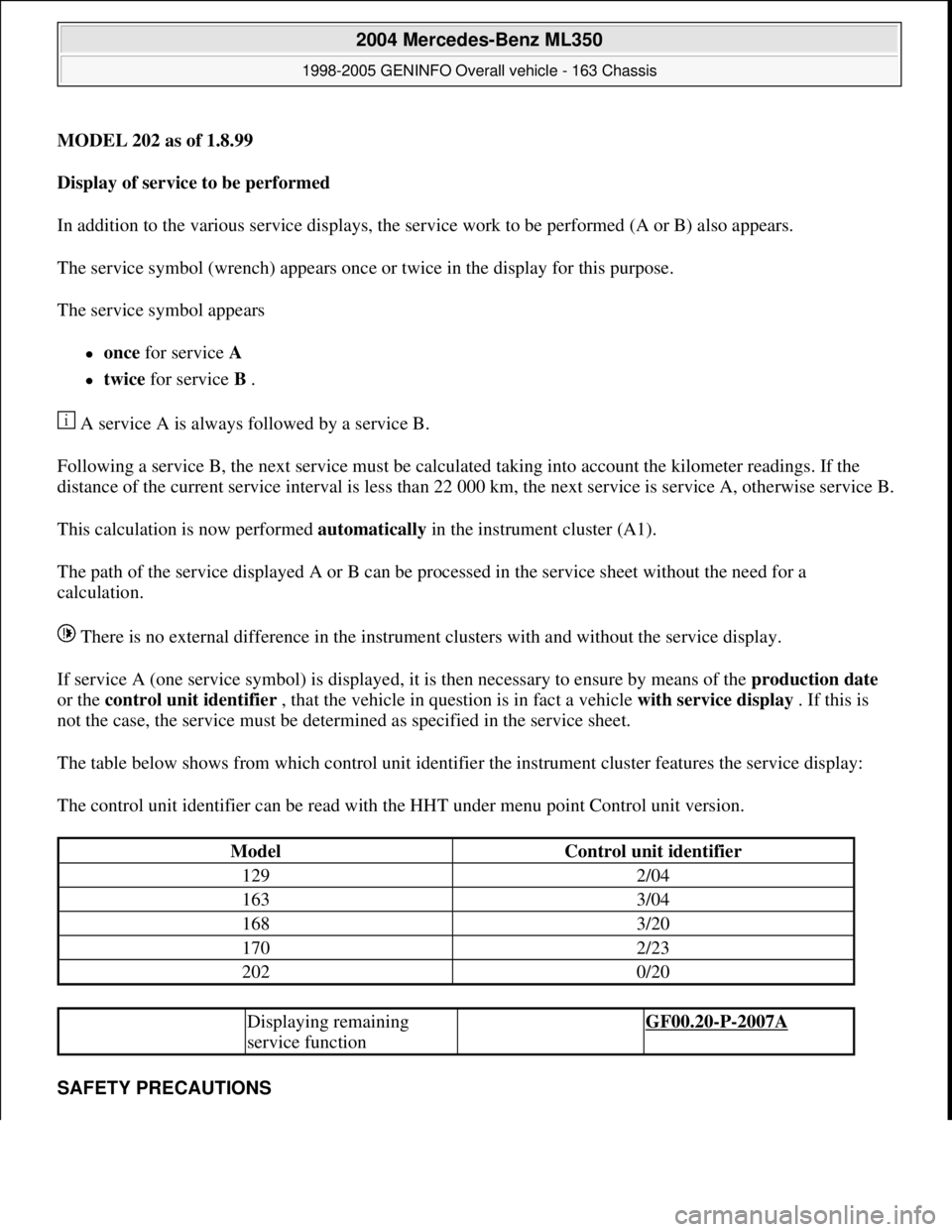
MODEL 202 as of 1.8.99
Display of service to be performed
In addition to the various service displays, the service work to be performed (A or B) also appears.
The service symbol (wrench) appears once or twice in the display for this purpose.
The service symbol appears
once for service A
twice for service B .
A service A is always followed by a service B.
Following a service B, the next service must be calculated taking into account the kilometer readings. If the
distance of the current service interval is less than 22 000 km, the next service is service A, otherwise service B.
This calculation is now performed automatically in the instrument cluster (A1).
The path of the service displayed A or B can be processed in the service sheet without the need for a
calculation.
There is no external difference in the instrument clusters with and without the service display.
If service A (one service symbol) is displayed, it is then necessary to ensure by means of the production date
or the control unit identifier , that the vehicle in question is in fact a vehicle with service display . If this is
not the case, the service must be determined as specified in the service sheet.
The table below shows from which control unit identifier the instrument cluster features the service display:
The control unit identifier can be read with the HHT under menu point Control unit version.
SAFETY PRECAUTIONS
ModelControl unit identifier
1292/04
1633/04
1683/20
1702/23
2020/20
Displaying remaining
service function GF00.20-P-2007A
2004 Mercedes-Benz ML350
1998-2005 GENINFO Overall vehicle - 163 Chassis
me
Saturday, October 02, 2010 3:47:47 PMPage 216 © 2006 Mitchell Repair Information Company, LLC.
Page 2862 of 4133
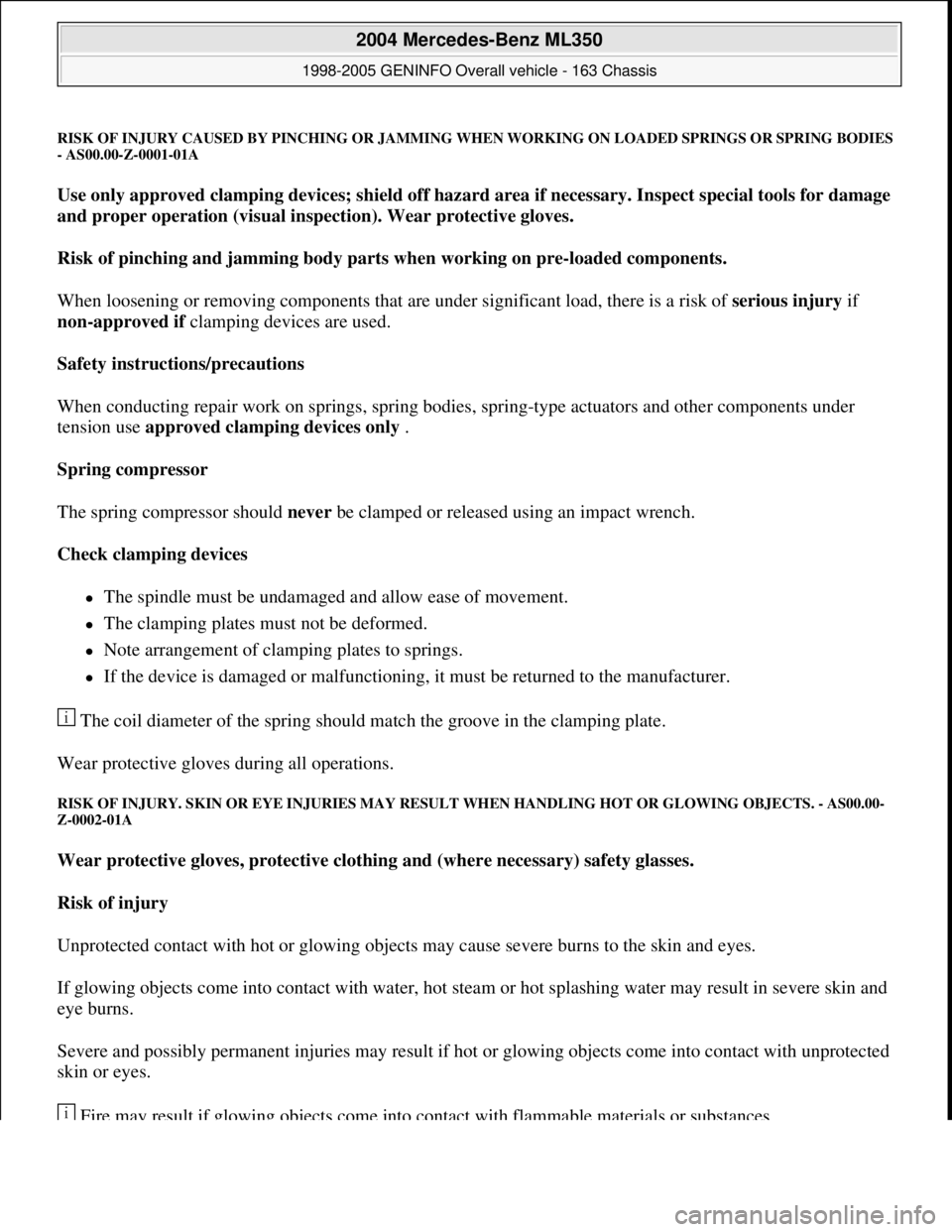
RISK OF INJURY CAUSED BY PINCHING OR JAMMING WHEN WORKING ON LOADED SPRINGS OR SPRING BODIES
- AS00.00-Z-0001-01A
Use only approved clamping devices; shield off hazard area if necessary. Inspect special tools for damage
and proper operation (visual inspection). Wear protective gloves.
Risk of pinching and jamming body parts when working on pre-loaded components.
When loosening or removing components that are under significant load, there is a risk of serious injury if
non-approved if clamping devices are used.
Safety instructions/precautions
When conducting repair work on springs, spring bodies, spring-type actuators and other components under
tension use approved clamping devices only .
Spring compressor
The spring compressor should never be clamped or released using an impact wrench.
Check clamping devices
The spindle must be undamaged and allow ease of movement.
The clamping plates must not be deformed.
Note arrangement of clamping plates to springs.
If the device is damaged or malfunctioning, it must be returned to the manufacturer.
The coil diameter of the spring should match the groove in the clamping plate.
Wear protective gloves during all operations.
RISK OF INJURY. SKIN OR EYE INJURIES MAY RESULT WHEN HANDLING HOT OR GLOWING OBJECTS. - AS00.00-
Z-0002-01A
Wear protective gloves, protective clothing and (where necessary) safety glasses.
Risk of injury
Unprotected contact with hot or glowing objects may cause severe burns to the skin and eyes.
If glowing objects come into contact with water, hot steam or hot splashing water may result in severe skin and
eye burns.
Severe and possibly permanent injuries may result if hot or glowing objects come into contact with unprotected
skin or eyes.
Fire ma
y result if glowing objects come into contact with flammable materials or substances.
2004 Mercedes-Benz ML350
1998-2005 GENINFO Overall vehicle - 163 Chassis
me
Saturday, October 02, 2010 3:47:47 PMPage 217 © 2006 Mitchell Repair Information Company, LLC.
Page 2863 of 4133
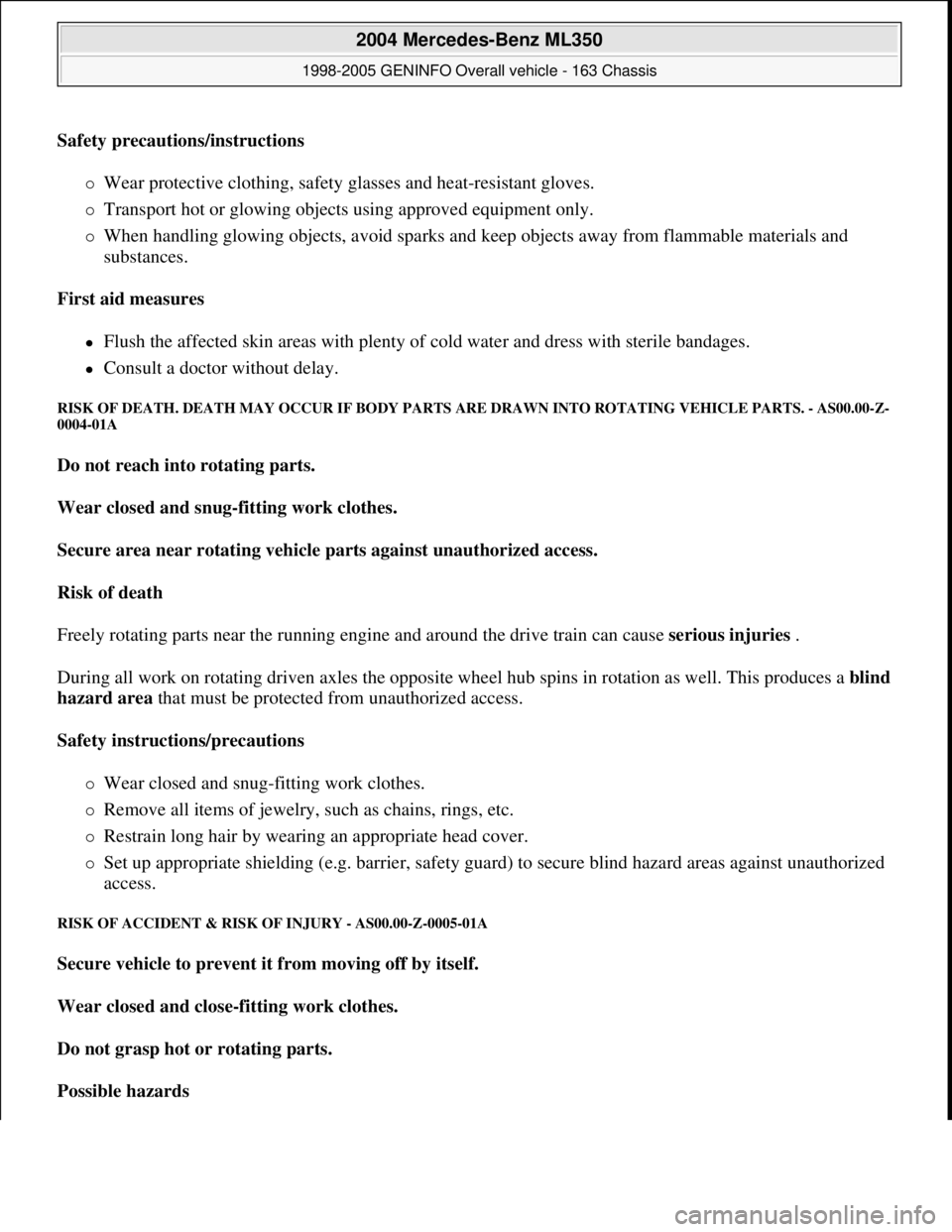
Safety precautions/instructions
Wear protective clothing, safety glasses and heat-resistant gloves.
Transport hot or glowing objects using approved equipment only.
When handling glowing objects, avoid sparks and keep objects away from flammable materials and
substances.
First aid measures
Flush the affected skin areas with plenty of cold water and dress with sterile bandages.
Consult a doctor without delay.
RISK OF DEATH. DEATH MAY OCCUR IF BODY PARTS ARE DRAWN INTO ROTATING VEHICLE PARTS. - AS00.00-Z-
0004-01A
Do not reach into rotating parts.
Wear closed and snug-fitting work clothes.
Secure area near rotating vehicle parts against unauthorized access.
Risk of death
Freely rotating parts near the running engine and around the drive train can cause serious injuries .
During all work on rotating driven axles the opposite wheel hub spins in rotation as well. This produces a blind
hazard area that must be protected from unauthorized access.
Safety instructions/precautions
Wear closed and snug-fitting work clothes.
Remove all items of jewelry, such as chains, rings, etc.
Restrain long hair by wearing an appropriate head cover.
Set up appropriate shielding (e.g. barrier, safety guard) to secure blind hazard areas against unauthorized
access.
RISK OF ACCIDENT & RISK OF INJURY - AS00.00-Z-0005-01A
Secure vehicle to prevent it from moving off by itself.
Wear closed and close-fitting work clothes.
Do not grasp hot or rotating parts.
Possible hazards
2004 Mercedes-Benz ML350
1998-2005 GENINFO Overall vehicle - 163 Chassis
me
Saturday, October 02, 2010 3:47:47 PMPage 218 © 2006 Mitchell Repair Information Company, LLC.
Page 2864 of 4133
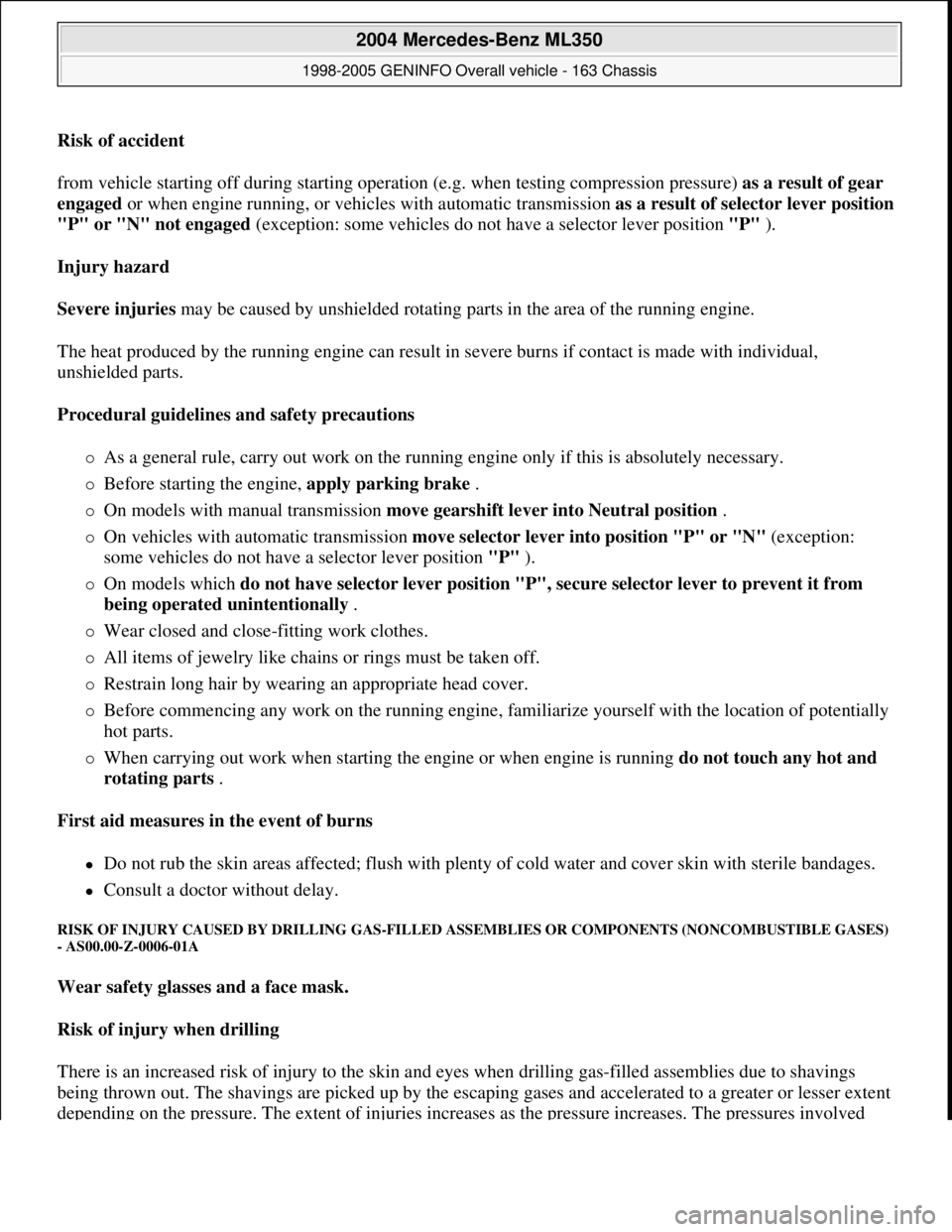
Risk of accident
from vehicle starting off during starting operation (e.g. when testing compression pressure) as a result of gear
engaged or when engine running, or vehicles with automatic transmission as a result of selector lever position
"P" or "N" not engaged (exception: some vehicles do not have a selector lever position "P" ).
Injury hazard
Severe injuries may be caused by unshielded rotating parts in the area of the running engine.
The heat produced by the running engine can result in severe burns if contact is made with individual,
unshielded parts.
Procedural guidelines and safety precautions
As a general rule, carry out work on the running engine only if this is absolutely necessary.
Before starting the engine, apply parking brake .
On models with manual transmission move gearshift lever into Neutral position .
On vehicles with automatic transmission move selector lever into position "P" or "N" (exception:
some vehicles do not have a selector lever position "P" ).
On models which do not have selector lever position "P", secure selector lever to prevent it from
being operated unintentionally .
Wear closed and close-fitting work clothes.
All items of jewelry like chains or rings must be taken off.
Restrain long hair by wearing an appropriate head cover.
Before commencing any work on the running engine, familiarize yourself with the location of potentially
hot parts.
When carrying out work when starting the engine or when engine is running do not touch any hot and
rotating parts .
First aid measures in the event of burns
Do not rub the skin areas affected; flush with plenty of cold water and cover skin with sterile bandages.
Consult a doctor without delay.
RISK OF INJURY CAUSED BY DRILLING GAS-FILLED ASSEMBLIES OR COMPONENTS (NONCOMBUSTIBLE GASES)
- AS00.00-Z-0006-01A
Wear safety glasses and a face mask.
Risk of injury when drilling
There is an increased risk of injury to the skin and eyes when drilling gas-filled assemblies due to shavings
being thrown out. The shavings are picked up by the escaping gases and accelerated to a greater or lesser extent
depending on the pressure. The extent of injuries increases as the pressure increases. The pressures involved
2004 Mercedes-Benz ML350
1998-2005 GENINFO Overall vehicle - 163 Chassis
me
Saturday, October 02, 2010 3:47:47 PMPage 219 © 2006 Mitchell Repair Information Company, LLC.
Page 2865 of 4133
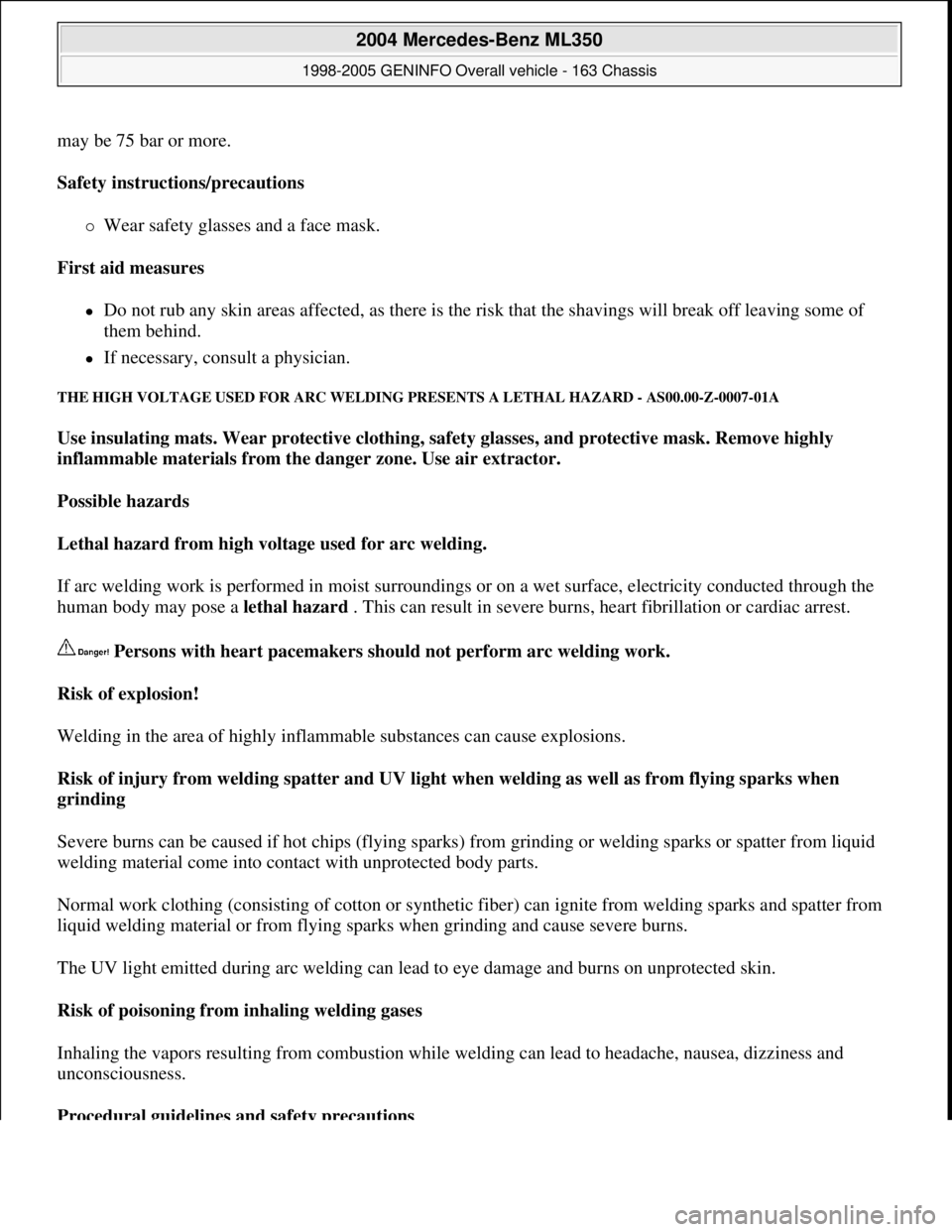
may be 75 bar or more.
Safety instructions/precautions
Wear safety glasses and a face mask.
First aid measures
Do not rub any skin areas affected, as there is the risk that the shavings will break off leaving some of
them behind.
If necessary, consult a physician.
THE HIGH VOLTAGE USED FOR ARC WELDING PRESENTS A LETHAL HAZARD - AS00.00-Z-0007-01A
Use insulating mats. Wear protective clothing, safety glasses, and protective mask. Remove highly
inflammable materials from the danger zone. Use air extractor.
Possible hazards
Lethal hazard from high voltage used for arc welding.
If arc welding work is performed in moist surroundings or on a wet surface, electricity conducted through the
human body may pose a lethal hazard . This can result in severe burns, heart fibrillation or cardiac arrest.
Persons with heart pacemakers should not perform arc welding work.
Risk of explosion!
Welding in the area of highly inflammable substances can cause explosions.
Risk of injury from welding spatter and UV light when welding as well as from flying sparks when
grinding
Severe burns can be caused if hot chips (flying sparks) from grinding or welding sparks or spatter from liquid
welding material come into contact with unprotected body parts.
Normal work clothing (consisting of cotton or synthetic fiber) can ignite from welding sparks and spatter from
liquid welding material or from flying sparks when grinding and cause severe burns.
The UV light emitted during arc welding can lead to eye damage and burns on unprotected skin.
Risk of poisoning from inhaling welding gases
Inhaling the vapors resulting from combustion while welding can lead to headache, nausea, dizziness and
unconsciousness.
Procedural guidelines and safety precautions
2004 Mercedes-Benz ML350
1998-2005 GENINFO Overall vehicle - 163 Chassis
me
Saturday, October 02, 2010 3:47:47 PMPage 220 © 2006 Mitchell Repair Information Company, LLC.
Page 2866 of 4133
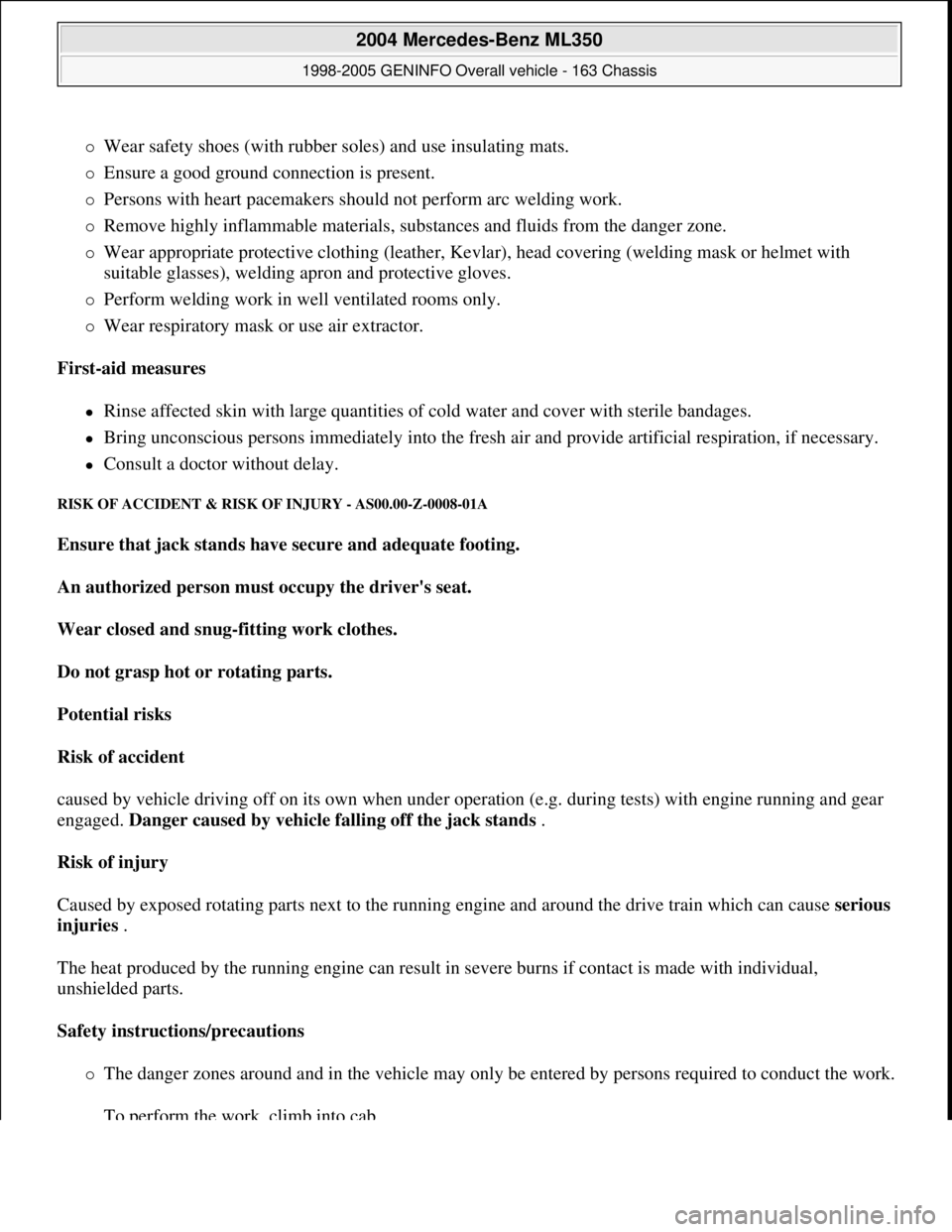
Wear safety shoes (with rubber soles) and use insulating mats.
Ensure a good ground connection is present.
Persons with heart pacemakers should not perform arc welding work.
Remove highly inflammable materials, substances and fluids from the danger zone.
Wear appropriate protective clothing (leather, Kevlar), head covering (welding mask or helmet with
suitable glasses), welding apron and protective gloves.
Perform welding work in well ventilated rooms only.
Wear respiratory mask or use air extractor.
First-aid measures
Rinse affected skin with large quantities of cold water and cover with sterile bandages.
Bring unconscious persons immediately into the fresh air and provide artificial respiration, if necessary.
Consult a doctor without delay.
RISK OF ACCIDENT & RISK OF INJURY - AS00.00-Z-0008-01A
Ensure that jack stands have secure and adequate footing.
An authorized person must occupy the driver's seat.
Wear closed and snug-fitting work clothes.
Do not grasp hot or rotating parts.
Potential risks
Risk of accident
caused by vehicle driving off on its own when under operation (e.g. during tests) with engine running and gear
engaged. Danger caused by vehicle falling off the jack stands .
Risk of injury
Caused by exposed rotating parts next to the running engine and around the drive train which can cause serious
injuries .
The heat produced by the running engine can result in severe burns if contact is made with individual,
unshielded parts.
Safety instructions/precautions
The danger zones around and in the vehicle may only be entered by persons required to conduct the work.
To perform the work, climb into cab.
2004 Mercedes-Benz ML350
1998-2005 GENINFO Overall vehicle - 163 Chassis
me
Saturday, October 02, 2010 3:47:47 PMPage 221 © 2006 Mitchell Repair Information Company, LLC.
Page 2867 of 4133
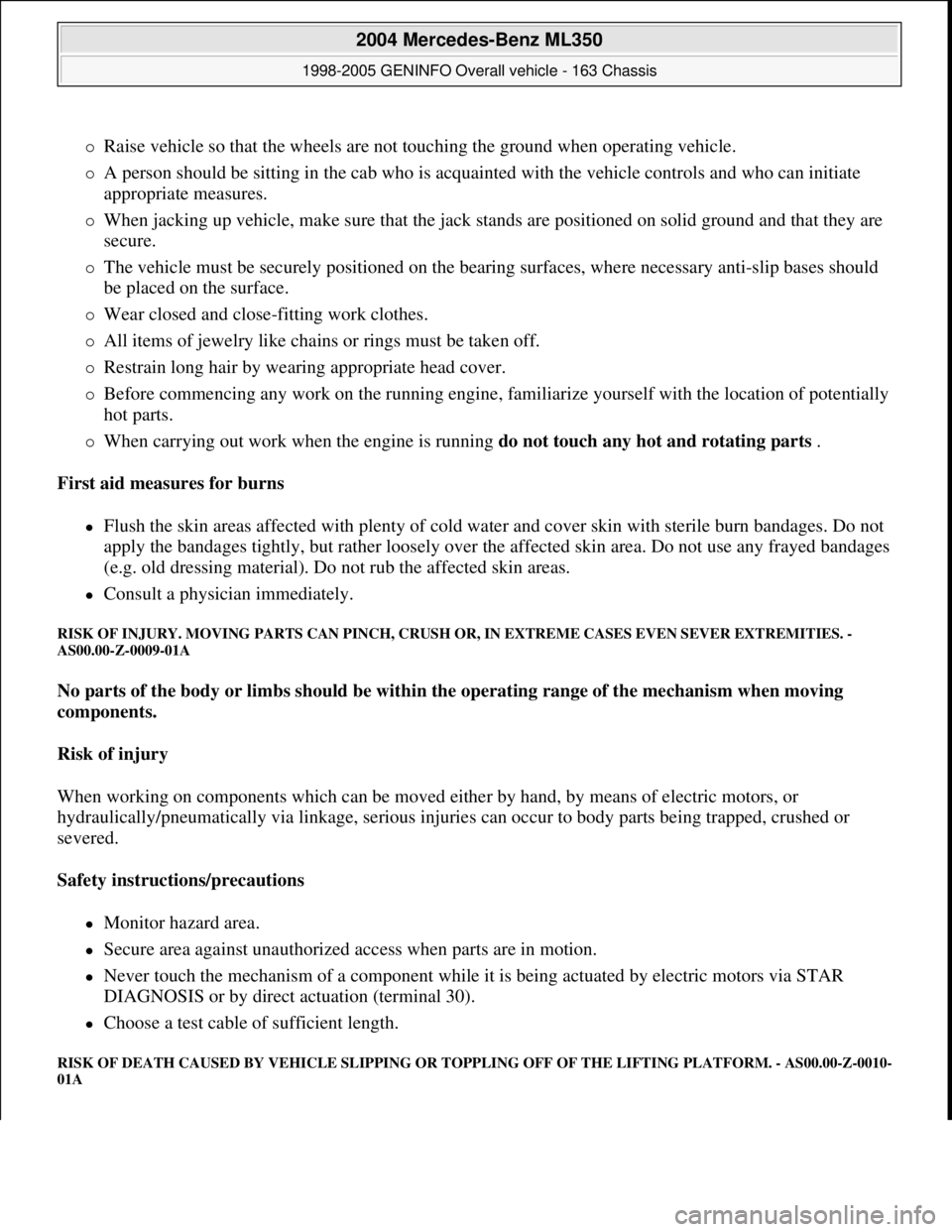
Raise vehicle so that the wheels are not touching the ground when operating vehicle.
A person should be sitting in the cab who is acquainted with the vehicle controls and who can initiate
appropriate measures.
When jacking up vehicle, make sure that the jack stands are positioned on solid ground and that they are
secure.
The vehicle must be securely positioned on the bearing surfaces, where necessary anti-slip bases should
be placed on the surface.
Wear closed and close-fitting work clothes.
All items of jewelry like chains or rings must be taken off.
Restrain long hair by wearing appropriate head cover.
Before commencing any work on the running engine, familiarize yourself with the location of potentially
hot parts.
When carrying out work when the engine is running do not touch any hot and rotating parts .
First aid measures for burns
Flush the skin areas affected with plenty of cold water and cover skin with sterile burn bandages. Do not
apply the bandages tightly, but rather loosely over the affected skin area. Do not use any frayed bandages
(e.g. old dressing material). Do not rub the affected skin areas.
Consult a physician immediately.
RISK OF INJURY. MOVING PARTS CAN PINCH, CRUSH OR, IN EXTREME CASES EVEN SEVER EXTREMITIES. -
AS00.00-Z-0009-01A
No parts of the body or limbs should be within the operating range of the mechanism when moving
components.
Risk of injury
When working on components which can be moved either by hand, by means of electric motors, or
hydraulically/pneumatically via linkage, serious injuries can occur to body parts being trapped, crushed or
severed.
Safety instructions/precautions
Monitor hazard area.
Secure area against unauthorized access when parts are in motion.
Never touch the mechanism of a component while it is being actuated by electric motors via STAR
DIAGNOSIS or by direct actuation (terminal 30).
Choose a test cable of sufficient length.
RISK OF DEATH CAUSED BY VEHICLE SLIPPING OR TOPPLING OFF OF THE LIFTING PLATFORM. - AS00.00-Z-0010-
01A
2004 Mercedes-Benz ML350
1998-2005 GENINFO Overall vehicle - 163 Chassis
me
Saturday, October 02, 2010 3:47:47 PMPage 222 © 2006 Mitchell Repair Information Company, LLC.
Page 2868 of 4133
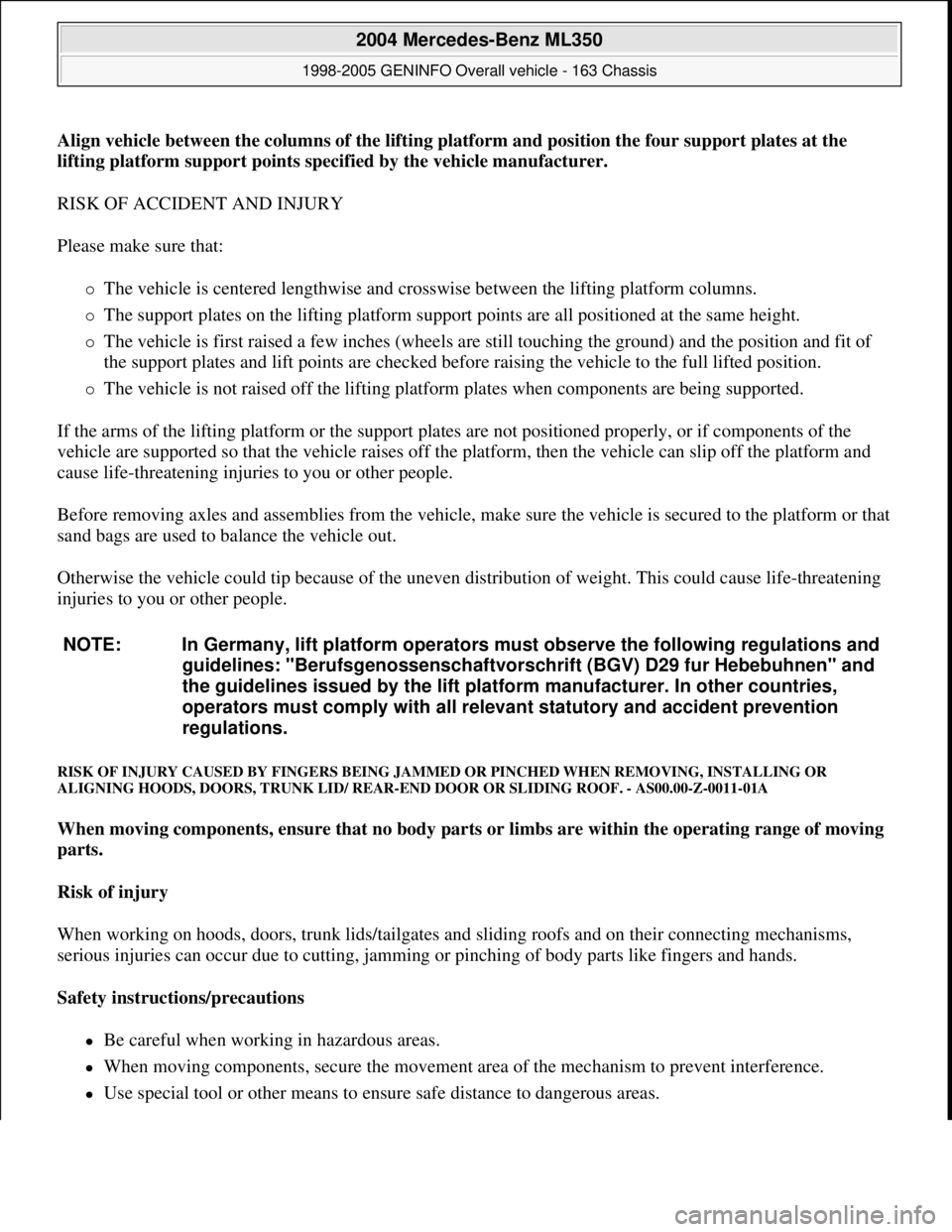
Align vehicle between the columns of the lifting platform and position the four support plates at the
lifting platform support points specified by the vehicle manufacturer.
RISK OF ACCIDENT AND INJURY
Please make sure that:
The vehicle is centered lengthwise and crosswise between the lifting platform columns.
The support plates on the lifting platform support points are all positioned at the same height.
The vehicle is first raised a few inches (wheels are still touching the ground) and the position and fit of
the support plates and lift points are checked before raising the vehicle to the full lifted position.
The vehicle is not raised off the lifting platform plates when components are being supported.
If the arms of the lifting platform or the support plates are not positioned properly, or if components of the
vehicle are supported so that the vehicle raises off the platform, then the vehicle can slip off the platform and
cause life-threatening injuries to you or other people.
Before removing axles and assemblies from the vehicle, make sure the vehicle is secured to the platform or that
sand bags are used to balance the vehicle out.
Otherwise the vehicle could tip because of the uneven distribution of weight. This could cause life-threatening
injuries to you or other people.
RISK OF INJURY CAUSED BY FINGERS BEING JAMMED OR PINCHED WHEN REMOVING, INSTALLING OR
ALIGNING HOODS, DOORS, TRUNK LID/ REAR-END DOOR OR SLIDING ROOF. - AS00.00-Z-0011-01A
When moving components, ensure that no body parts or limbs are within the operating range of moving
parts.
Risk of injury
When working on hoods, doors, trunk lids/tailgates and sliding roofs and on their connecting mechanisms,
serious injuries can occur due to cutting, jamming or pinching of body parts like fingers and hands.
Safety instructions/precautions
Be careful when working in hazardous areas.
When moving components, secure the movement area of the mechanism to prevent interference.
Use special tool or other means to ensure safe distance to dangerous areas. NOTE: In Germany, lift platform operators must observe the following regulations and
guidelines: "Berufsgenossenschaftvorschrift (BGV) D29 fur Hebebuhnen" and
the guidelines issued by the lift platform manufacturer. In other countries,
operators must comply with all relevant statutory and accident prevention
regulations.
2004 Mercedes-Benz ML350
1998-2005 GENINFO Overall vehicle - 163 Chassis
me
Saturday, October 02, 2010 3:47:47 PMPage 223 © 2006 Mitchell Repair Information Company, LLC.
Page 2869 of 4133
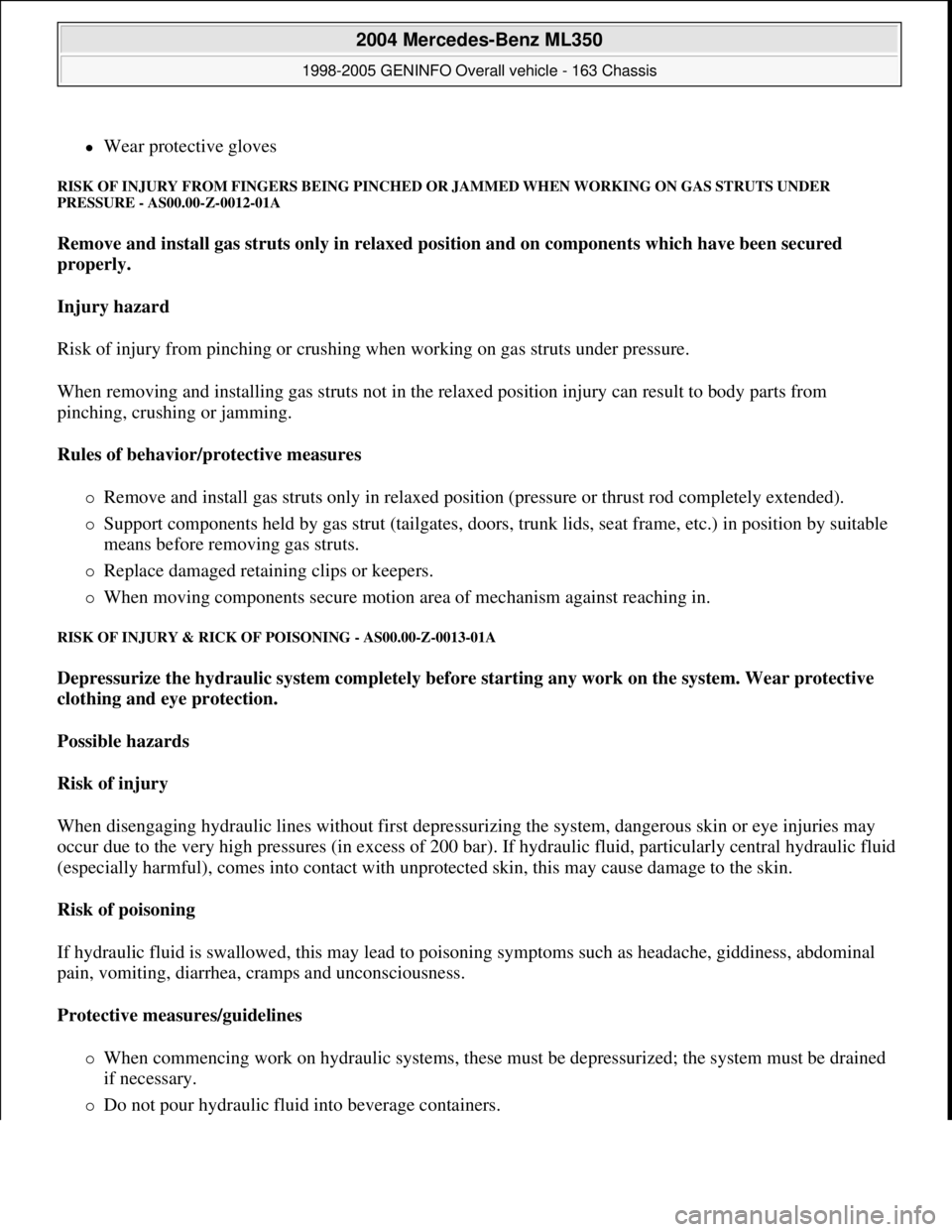
Wear protective gloves
RISK OF INJURY FROM FINGERS BEING PINCHED OR JAMMED WHEN WORKING ON GAS STRUTS UNDER
PRESSURE - AS00.00-Z-0012-01A
Remove and install gas struts only in relaxed position and on components which have been secured
properly.
Injury hazard
Risk of injury from pinching or crushing when working on gas struts under pressure.
When removing and installing gas struts not in the relaxed position injury can result to body parts from
pinching, crushing or jamming.
Rules of behavior/protective measures
Remove and install gas struts only in relaxed position (pressure or thrust rod completely extended).
Support components held by gas strut (tailgates, doors, trunk lids, seat frame, etc.) in position by suitable
means before removing gas struts.
Replace damaged retaining clips or keepers.
When moving components secure motion area of mechanism against reaching in.
RISK OF INJURY & RICK OF POISONING - AS00.00-Z-0013-01A
Depressurize the hydraulic system completely before starting any work on the system. Wear protective
clothing and eye protection.
Possible hazards
Risk of injury
When disengaging hydraulic lines without first depressurizing the system, dangerous skin or eye injuries may
occur due to the very high pressures (in excess of 200 bar). If hydraulic fluid, particularly central hydraulic fluid
(especially harmful), comes into contact with unprotected skin, this may cause damage to the skin.
Risk of poisoning
If hydraulic fluid is swallowed, this may lead to poisoning symptoms such as headache, giddiness, abdominal
pain, vomiting, diarrhea, cramps and unconsciousness.
Protective measures/guidelines
When commencing work on hydraulic systems, these must be depressurized; the system must be drained
if necessary.
Do not pour hydraulic fluid into beverage containers.
2004 Mercedes-Benz ML350
1998-2005 GENINFO Overall vehicle - 163 Chassis
me
Saturday, October 02, 2010 3:47:47 PMPage 224 © 2006 Mitchell Repair Information Company, LLC.
Page 2870 of 4133
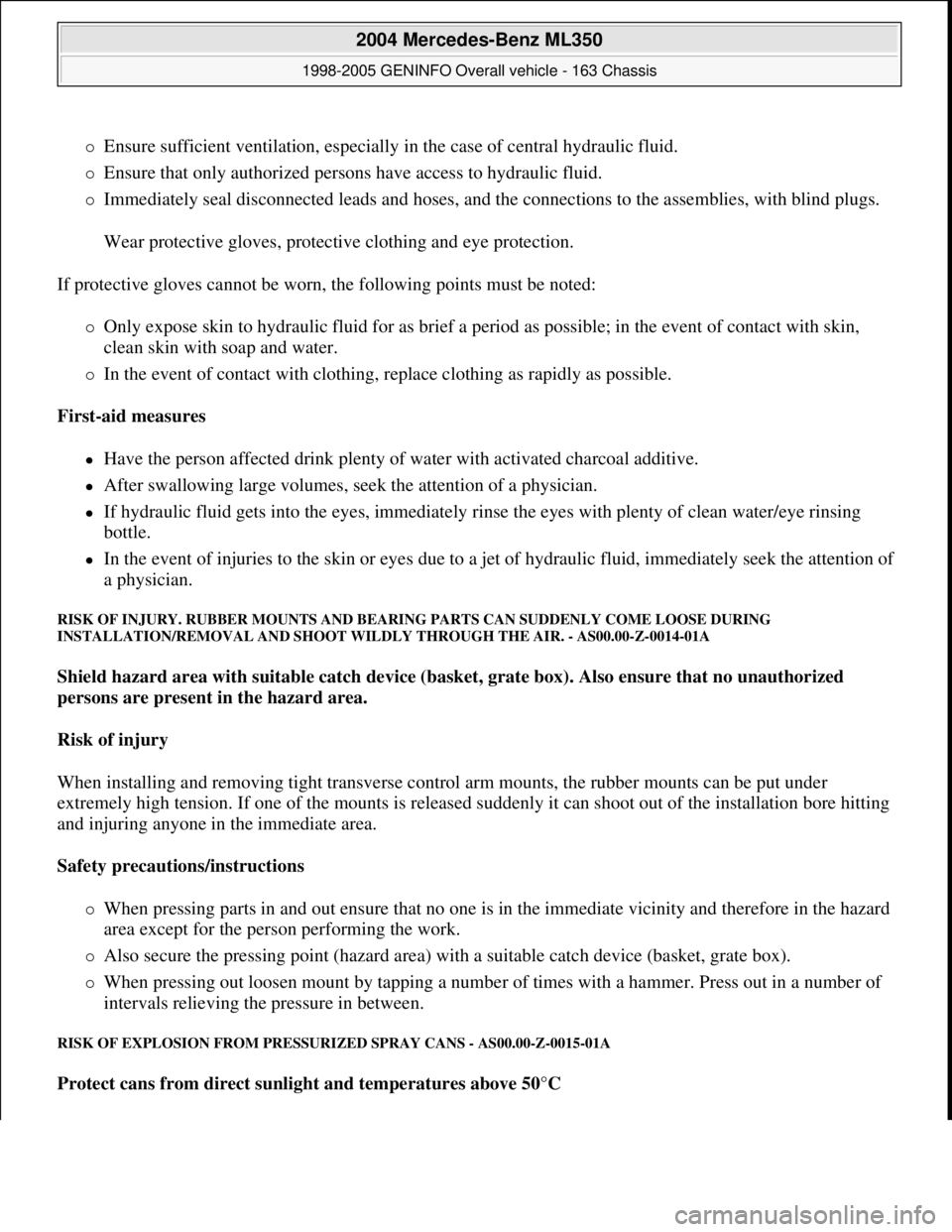
Ensure sufficient ventilation, especially in the case of central hydraulic fluid.
Ensure that only authorized persons have access to hydraulic fluid.
Immediately seal disconnected leads and hoses, and the connections to the assemblies, with blind plugs.
Wear protective gloves, protective clothing and eye protection.
If protective gloves cannot be worn, the following points must be noted:
Only expose skin to hydraulic fluid for as brief a period as possible; in the event of contact with skin,
clean skin with soap and water.
In the event of contact with clothing, replace clothing as rapidly as possible.
First-aid measures
Have the person affected drink plenty of water with activated charcoal additive.
After swallowing large volumes, seek the attention of a physician.
If hydraulic fluid gets into the eyes, immediately rinse the eyes with plenty of clean water/eye rinsing
bottle.
In the event of injuries to the skin or eyes due to a jet of hydraulic fluid, immediately seek the attention of
a physician.
RISK OF INJURY. RUBBER MOUNTS AND BEARING PARTS CAN SUDDENLY COME LOOSE DURING
INSTALLATION/REMOVAL AND SHOOT WILDLY THROUGH THE AIR. - AS00.00-Z-0014-01A
Shield hazard area with suitable catch device (basket, grate box). Also ensure that no unauthorized
persons are present in the hazard area.
Risk of injury
When installing and removing tight transverse control arm mounts, the rubber mounts can be put under
extremely high tension. If one of the mounts is released suddenly it can shoot out of the installation bore hitting
and injuring anyone in the immediate area.
Safety precautions/instructions
When pressing parts in and out ensure that no one is in the immediate vicinity and therefore in the hazard
area except for the person performing the work.
Also secure the pressing point (hazard area) with a suitable catch device (basket, grate box).
When pressing out loosen mount by tapping a number of times with a hammer. Press out in a number of
intervals relieving the pressure in between.
RISK OF EXPLOSION FROM PRESSURIZED SPRAY CANS - AS00.00-Z-0015-01A
Protect cans from direct sunlight and temperatures above 50°C
2004 Mercedes-Benz ML350
1998-2005 GENINFO Overall vehicle - 163 Chassis
me
Saturday, October 02, 2010 3:47:48 PMPage 225 © 2006 Mitchell Repair Information Company, LLC.